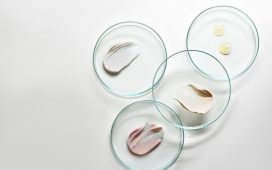The feature wall – that seemingly bold decorative decision to paint one wall in the room a stand-out colour – is dead. Colour is now spreading through our homes, up staircases, across woodwork and ceilings, filling in neutral spaces with rhubarb, verdigris green, aubergine and orange. Is it a terrifying trend we’ll all pay for in gallons of undercoat, or does this colour craving signify something else?
“There’s been a seismic shift in how we’re thinking about colour,” says Farrow & Ball’s long-standing colour curator, Joa Studholme. “I am convinced the rise of bold colour comes down to the fact that the world is in such a mess. We want to go home and have colours that nourish us, that give us a hug. Pure white walls simply don’t do that. They don’t look after you.”
For interior designer Nicola Harding, one half of the design studio Harding & Read, colour correlates to feeling. “Certain combinations can key into something on a deeper level, they can transport you to a moment in time. That’s the alchemy of colour.” More than a mere surface decision, it seems we are searching for something altogether more enriching when we pop the lid on a tester pot.
How to begin
If you are tempted to try colour on some of your neutral walls, the advice is refreshingly simple: choose a colour you actually like. “It sounds stupidly obvious,” says interior designer Francesca Rowan Plowden, “but don’t go for a colour because it’s on trend, or you’ve seen it in a magazine. You have got to live with it.”
Rowan Plowden, whose colourful, cossetting interiors can be experienced in the heritage rental properties at Goodnestone Park, Battel Hall and Elmley Nature Reserve, suggests you seek inspiration from your natural surroundings, a treasured accessory, favourite fabric or painting.

“Paintings are quite often a starting point for me,” she says. “If there’s a painting you love, look at the palette and choose your colours based on what’s in it. A recent palette of yellow woodwork and rust-coloured chairs was based on the colours in a painting I found at Ardingly Antiques Fair.”
Studholme agrees with this approach: “You must do what resonates with you.” If you’re wary of full colour, she suggests testing your tolerance with smaller spaces, such as the inside of a cupboard, or a bright window reveal. “If every time you open the cupboard it gives you joy, you can start to take it further,” she says.
Make an entrance
For Studholme, the hallway is the best place to use bold colour because “It gives you drama when you first enter your home.” Studholme, who offers customers personalised colour consultations, has seen a proliferation of “sexy” deep green, charcoal and inky blue hallways (“Although I think blue is slightly on the wane now,” she confides).
Artist and designer Luke Edward Hall, who has painted the entrance to his Camden flat a glossy, yolk yellow, agrees: “When I come home and it’s grey and grim, it instantly puts a smile on my face. Colour for me is linked to optimism. It’s about bringing joy and cheer into the home.” Hall and his partner, designer Duncan Campbell, are currently decorating their cottage in Gloucestershire. It’s still a work-in-progress, but so far every room in the house has been painted a different colour.

“We knew we wanted an olive-green living space and a mustard-coloured dining room. From there, we’ve chosen lilac, bright blue and arsenic rooms – it’s completely mad,” he admits. Each room has been approached individually, but there is an overall sense of balance. “You see glimpses of the rooms throughout the house, so you do have to think about which colours will work together.”
Harding often uses painted woodwork to pull connecting rooms together. “We frequently paint the woodwork a darker colour to the walls – it feels so much more comfortable. This includes skirting, doors, window frames and bars. This has the added benefit of bringing the outside into the home, because your eye passes through the frame to the view beyond.”
Colour tricks
Rowan Plowden suggests painting woodwork the same shade as the walls, sometimes in a gloss. “It looks really chic and makes the room look bigger,” she says. In kitchens, overhead cupboards are also painted the same colour as the wall, which makes the space feel “less kitcheny”. Conversely, says Studholme, kitchen islands are crying out for bold colour: “It’s below your eyeline, so it’s not too scary and it will make everything around it feel bigger and lighter.”
Both Harding and Studholme are known to take colour above the eyeline, too. “A painted ceiling is a magical thing, without being too in-your-face,” says Studholme. “I love using ceilings, rather than letting them become an afterthought,” Harding adds. “A painted ceiling affects how the space feels.”
Filling the room
When choosing a colour, the advice is to paint a large, thick piece of card in your test colour and move it around the room at different times throughout the day. Even so, you should be prepared for some shocks, says Rowan Plowden. “When the colour [Farrow & Ball’s Eating Room Red] for the library in Battel Hall first went on I thought: ‘Oh my God, I’ve created a womb.’ Seeing the room empty in the colour you’ve chosen will scare you,” she warns, “but you need to push through that and start filling the room. If your colour choice has come from a place of inspiration, be brave and stick with it.”

Bold walls also affect the objects in a room. “A blue velvet chair against a pale grey wall can look quite tame,” explains Rowan Plowden. “Put a blue velvet chair against a deep blue wall and it will immediately look more luxurious.”
For Harding, bold-painted furniture is an affordable way of sharpening a scheme and injecting colour. Studholme agrees: “Try taking an old dining chair and painting it a gloss red,” Studholme suggests. “It will create a little moment in your house which you can move around or change. What could be more fun?”
Joa Studholme’s Recipes for Decorating is £26.40 at guardianbookshop.com. Luke Edward Hall’s Greco Disco is £39.60 at guardianbookshop.com













